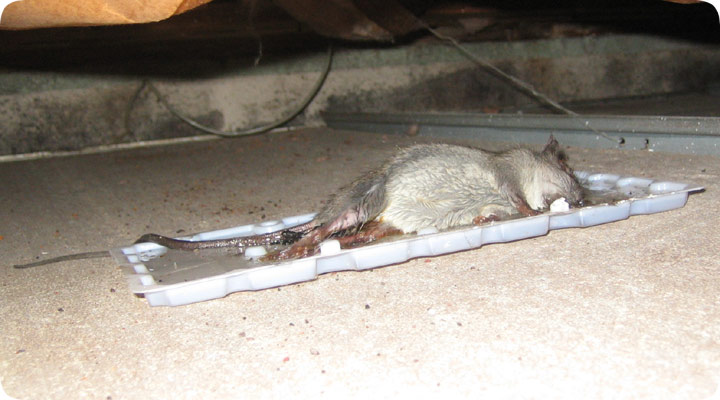-
info@aaanimalcontrol.com
Call us for help in your town
Humane Wildlife Education
Dead Rat on Glueboard - Do Glue Boards Catch Rodents?

06.12.2005 - I arrived at a school in order to investigate a bad smell in one of the classrooms. The school had abandoned use of the room for a couple of days due to the odor, and finally decided to call me out to find and remove the source of the smell. Most dead animal jobs take me either five minutes or two hours. That is, the animal is either dead in some obvious and easy to access location, or it has died in some impossible to find and impossible to reach area.
This was a five-minute job. I opened the drop ceiling panels, and voila, I found a dead rat stuck to a glue board. The school had hired a generic pest control company to perform rat extermination. They did a lousy job. Their solution was to set glue traps. While trapping is only one part of rat control (finding and sealing shut the entry points into the building is the most important step), it's still important to use the correct traps. I do not like glue boards, and have never used them for rat control. The capture rate is low, rats can often pull themselves free, and they are also comparatively inhumane. Whereas a snap trap quickly kills the rat, the animal must slowly suffer and die of starvation on the glue board.
Another mistake that the pest control company made was in not checking their traps! They set this one a long time ago, and by chance happened to catch one (proof that the schools rat problem was never actually solved) and now the school got the odor.
I removed the rat with the glue board and offered to provide a complete and permanent solution, but the school declined. Maybe they'll learn their lesson when they get another stink in one of the classrooms. Anyway, as was the case when I was a lad, I was glad
to leave a stinky old school and get back out in the fresh air. And folks, please don't use glueboards for rodent control. That's my lesson for the day.
Do it yourself: Visit my How To Find and Get Rid of Dead Animals page for tips and advice.
Get professional help: Visit my Nationwide Pro Directory of wildlife removal experts.
For more wildlife stories, click my Wildlife Blog
or click my below banner to hire a local trapper.
Glue boards: What are they and how do they work?
Glue boards, or more commonly known as glue traps, are best defined as trays that have an extremely sticky adhesive on its exterior. Easily available at any grocery, home improvement, and hardware store, they are mostly used to trap insects, rodents, and snakes. It works as an adhesive board that gets the animal stuck to the tray and renders them immobile. The result is a slow death by either starvation or suffocation.
Advantages and disadvantages
Admittedly, glue traps are easy to follow and save you the hassle of calling in a professional and provide quick results but what may seem like an easy solution for you isn't completely so. They are one of the cruelest and dangerous solutions for animal control on the market and ensures that the animal will suffer for a long time before succumbing to death. They are also rendered to be ineffective in areas where there is a lot of dust, air, and water and in most cases, can only trap juvenile rats as older rats have enough experience to know how to avoid it. Moreover, what makes matters worse is that glue bards are not reusable and therefore, consequently, not price-friendly. Another disadvantage that arises as a risk is that if you were to get close to the trap while the rodent is still alive, you would risk getting bit and the spread of disease. Since glue boards kill its prey slowly, chances are that you would come across an alive rodent and put your health at risk.
Are glue boards effective in catching rodents?
Though this question has no definite or straightforward answer, what you need to know is that glue boards come up with their own set of advantages and disadvantages. On one hand, they can easily trap rats and take care of all the overpopulation issues but on the other hand, the animal suffers a lot before they do. Glue traps can also keep a track of insect activity and prevent escape. To make glue boards the most efficient at catching rodents, daily inspection should be carried out as captured rodents will sometimes use their own urine, hair, or feces to make their escape. Most people tend to avoid using glue boards in an attempt to catch rodents as they consider them to be highly inhumane and ineffective. They suggest the usage of snap traps as an alternative as that is a more effective way of getting rid of a rodent.




















